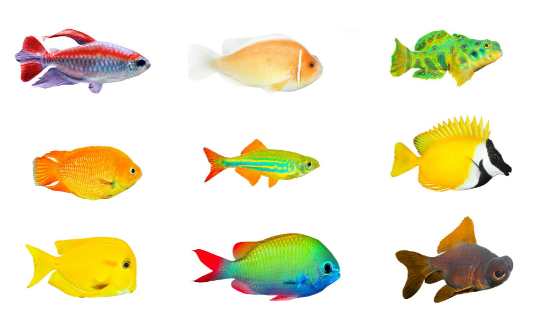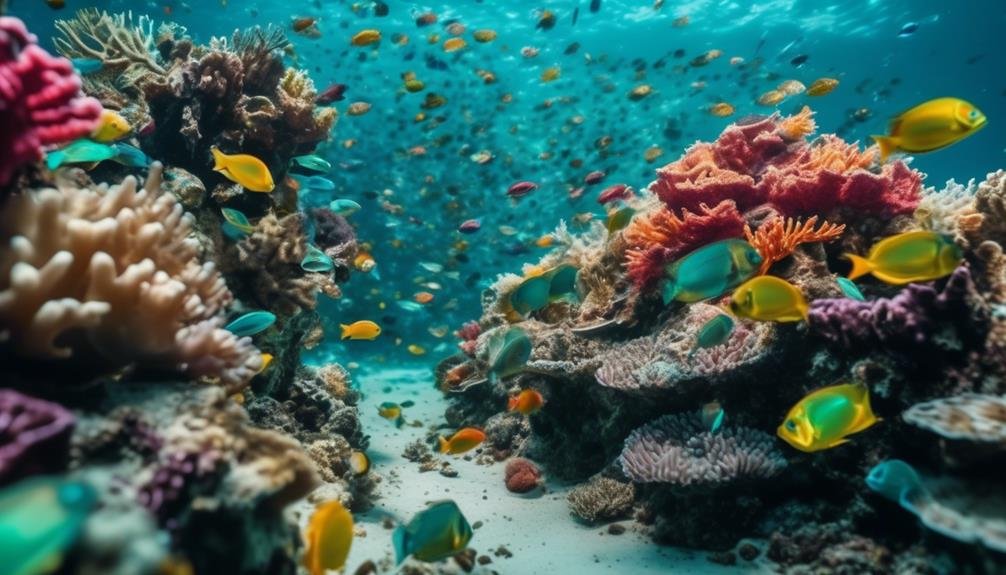
Imagine stepping into a mesmerizing kaleidoscope where vibrant colors blend seamlessly with cunning behavior.
This is the world of wrasse, a diverse family of saltwater fish that will leave you awestruck. With over 600 species to discover, each with their own unique characteristics, you'll be captivated by their beauty and intrigued by their intelligence.
But what lies beneath the surface of these colorful creatures? What secrets do they hold?
Join us as we peel back the layers of their fascinating existence and uncover the captivating world of wrasse.
Key Takeaways
- Wrasse are a diverse family of saltwater fish with over 600 species, known for their vibrant colors and ability to blend in with their surroundings.
- They inhabit various habitats such as coral reefs, rocky areas, and seagrass beds, and play a crucial role in controlling populations of certain organisms in reef ecosystems.
- Wrasse have interesting reproductive strategies, with some species changing gender during their lifetime and exhibiting complex courtship behaviors.
- Conservation efforts are important to protect wrasse species, as they are threatened by overfishing and habitat destruction, and their presence is vital for maintaining healthy coral reef ecosystems.
Wrasse Diversity: A Kaleidoscope of Colors
The world of wrasse is a kaleidoscope of colors, showcasing the vibrant hues and mesmerizing patterns that make these fish truly remarkable.
From the striking blue and yellow stripes of the yellowtail wrasse to the iridescent green and purple scales of the dragon wrasse, each species boasts its own unique palette.
These colors serve multiple purposes in the underwater realm. Some wrasse use their vibrant hues to attract mates, while others rely on camouflage to blend seamlessly into their surroundings, evading predators.
The intricate patterns and shades found on wrasse make them a sight to behold, whether you encounter them in a coral reef or a rocky area.
Their stunning colors are a testament to the beauty and diversity of the underwater world.
Wrasse Habitat: Exploring Tropical Waters
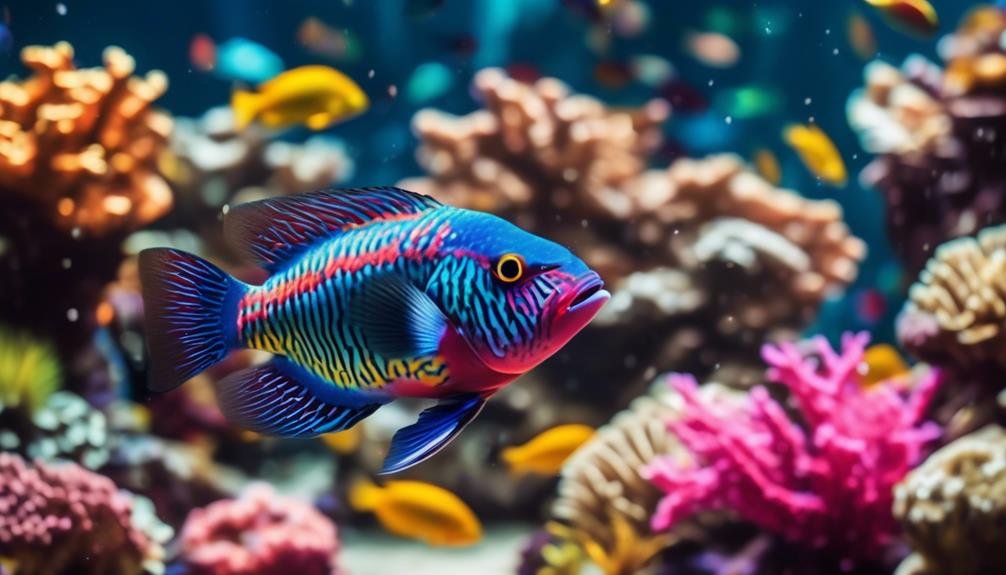
As we dive deeper into the world of wrasse, let's now turn our attention to their fascinating habitat in tropical waters.
Wrasse can be found in a variety of habitats such as coral reefs, rocky areas, and seagrass beds. Some species prefer shallow waters, while others inhabit deeper areas. They're known to be territorial and may establish cleaning stations. In addition, certain wrasse species have the ability to burrow in the sand.
These colorful fish play an important role in reef ecosystems by controlling populations of certain organisms. Their vibrant colors and ability to blend in with their surroundings make them a captivating sight to behold in the tropical waters they call home.
Wrasse Feeding Habits: Carnivorous and Clever
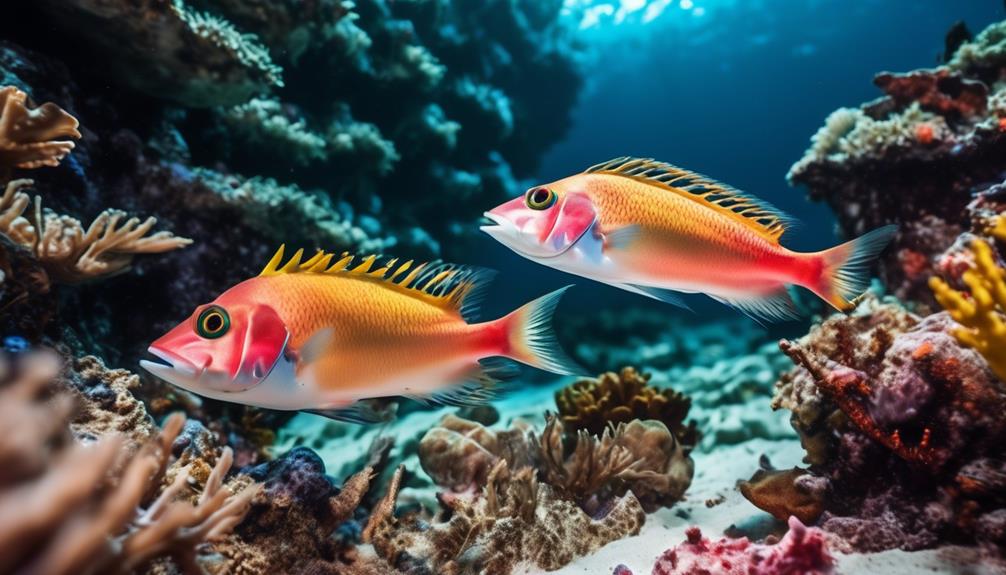
Wrasse exhibit carnivorous feeding habits and demonstrate clever strategies to acquire their prey. These colorful fish have a diverse diet that includes small invertebrates, crustaceans, and even other fish. Some species of wrasse have specialized feeding behaviors, such as picking parasites off other fish, while others use their strong jaws and sharp teeth to capture and consume their prey.
Wrasse are also known for their clever hunting techniques. For example, some species will hide in crevices or bury themselves in sand, waiting patiently for their prey to come close before striking. Others, like the cleaner wrasse, establish cleaning stations where they remove parasites from larger fish, forming mutually beneficial relationships.
These carnivorous and cunning feeding habits make wrasse fascinating creatures to observe in their natural habitats.
Wrasse Reproduction: Gender-Bending Strategies
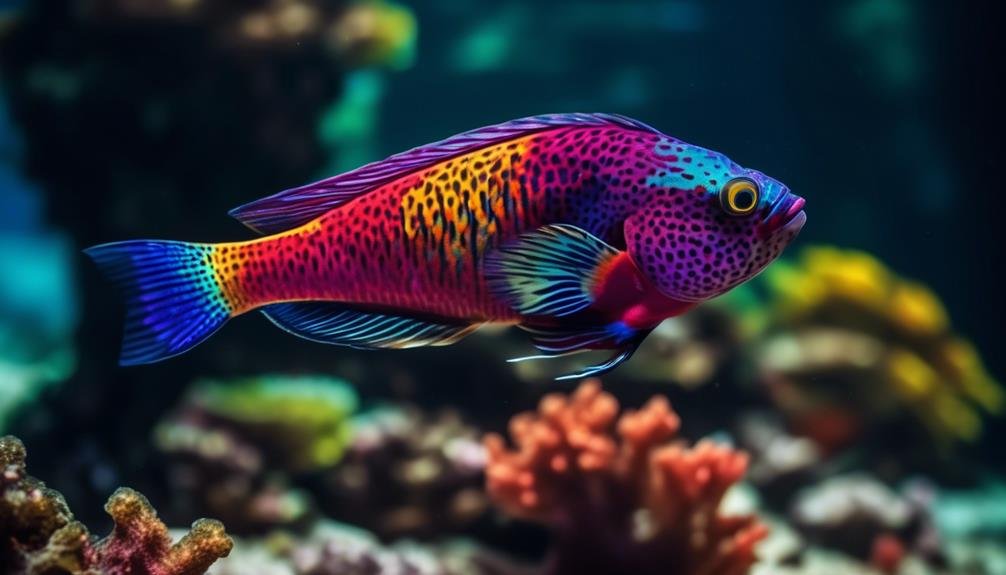
After observing the clever hunting techniques and diverse feeding habits of wrasse, it's intriguing to explore their unique reproductive strategies, particularly their gender-bending strategies.
- Gender-changing: Some wrasse species have the ability to change gender during their lifetime. Dominant males can become females, a phenomenon known as protogyny. This allows for the maintenance of a balanced population and ensures reproductive success.
- Complex courtship: Certain wrasse species engage in elaborate courtship behaviors. Males may display vibrant colors, create intricate mating displays, or build nests to attract females. These rituals help establish dominance and facilitate successful reproduction.
- Sneaky tactics: In wrasse populations with dominant males, smaller, subordinate males may adopt sneaky tactics to reproduce. They disguise themselves as females to avoid aggression from dominant males and gain access to mating opportunities.
- Harems: Some wrasse species form harems, where a dominant male mates with multiple females. This strategy ensures a continuous supply of eggs and increases the chances of successful reproduction.
Wrasse reproductive strategies are fascinating and demonstrate the adaptability and diversity of these colorful fish.
Wrasse Conservation: Protecting Precious Ecosystems
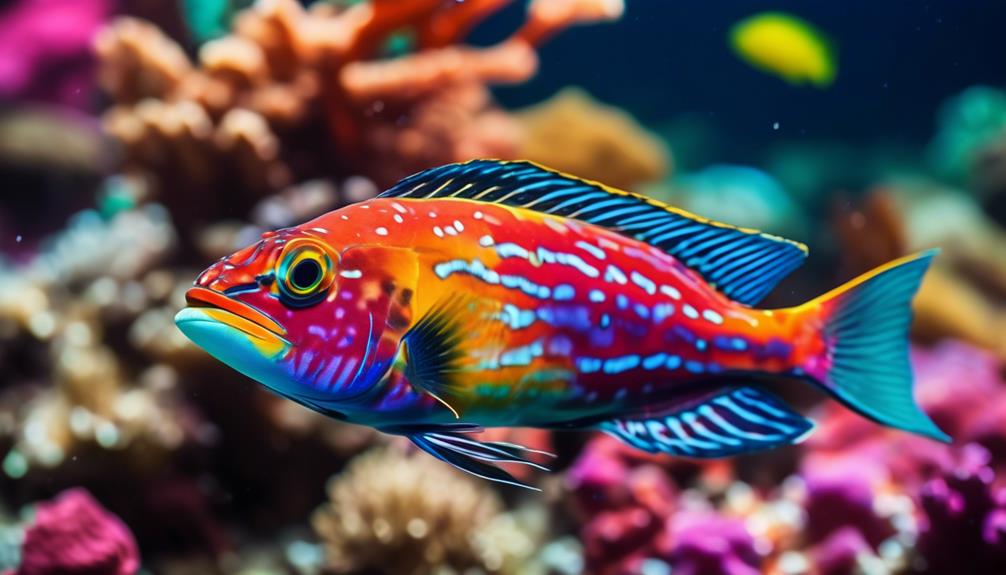
To effectively safeguard the delicate ecosystems that wrasse inhabit, conservation efforts must be prioritized and implemented. Wrasse play a crucial role in maintaining the health and balance of coral reef ecosystems.
However, some species of wrasse are currently facing threats such as overfishing and habitat destruction. To protect these precious ecosystems, it's important to focus on conserving coral reefs and implementing sustainable fishing practices.
Many countries have already taken steps to safeguard wrasse populations by establishing marine protected areas. Public awareness and education are also vital in ensuring the conservation of wrasse species.
Frequently Asked Questions
What Is the Lifespan of a Wrasse?
The lifespan of a wrasse varies depending on the species, but generally, they can live up to 15-20 years in the wild. However, in captivity, with proper care, some species can live even longer.
Can Wrasse Be Kept in a Freshwater Aquarium?
No, wrasse cannot be kept in a freshwater aquarium. They are saltwater fish that require specific conditions and cannot survive in a freshwater environment. Make sure to provide them with the right habitat.
Are All Wrasse Species Able to Change Gender?
No, not all wrasse species are able to change gender. Some wrasse species have the ability to change gender during their lifetime, with dominant males becoming females. However, this behavior varies among different species.
Do Wrasse Require a Specific Water Temperature in Their Aquarium?
No, wrasse do not require a specific water temperature in their aquarium. They are adaptable to a wide range of temperatures, but it is important to maintain stable water conditions for their overall health and well-being.
Are There Any Species of Wrasse That Are Venomous?
Yes, there are certain species of wrasse that are venomous. These venomous wrasse have specialized glands that produce toxins, which they use for defense against predators.
What Makes Wrasse Colorful and Cunning in the Underwater World?
The colorful sweetlips secrets revealed in the underwater world lie in the vibrant and striking hues of the wrasse. Their ability to change colors not only captivates the eyes but also serves as a cunning camouflage in the diverse underwater environment, making them adept hunters and survivors in the wild.
Conclusion
So, now that you've delved into the vibrant and captivating world of wrasse, you have discovered their diverse colors, cunning behavior, and important role in reef ecosystems. With their ability to change gender and their unique feeding habits, these fish are truly fascinating creatures.
However, their conservation is crucial to preserve their habitats and ensure their survival. By learning about their needs and taking steps to protect them, we can contribute to the well-being of these remarkable and valuable fish.




